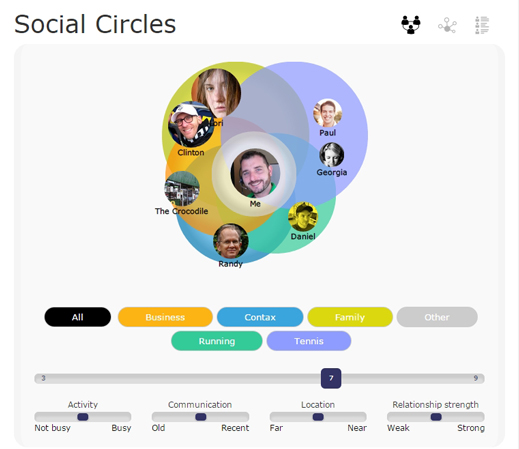AT&T Builds an Assistant App with Social Skills
Virtual assistant apps, such as Apple’s Siri or Google Now, focus mostly on providing factual info such as search results and flight times. A new assistant called Contax, developed by researchers at AT&T, tries to be more genuinely “personal,” by actively helping you organize your social life.

Contax analyzes your call logs and text messaging patterns to work out your most important relationships. The app then uses that information to reorganize your address book, and actively suggest, for example, that you should call or text your tennis buddy like you do every week the day before your game.
AT&T’s app tries to get a measure of who matters to you by rating contacts on qualities including the strength of your relationship, physical proximity, and the patterns of your communications with them. You can also assign contacts to important categories, like “family,” “friends,” “project team,” or “fishing buddies.”
Instead of displaying an alphabetized list of thousands of names, Contax actively curates what the app terms your “social circle.” A graphic showing from three to nine people that it judges you’re most likely to want to contact at that moment, based on your past behavior.
The exact collection of people shown in your social circle might be different between workdays and weekends, for example. It can also vary at different times of day. The idea is that when you pull out your phone to call or text someone, Contax has made them just a single tap away. The same information is used by the app to proactively suggest that you call or text someone. The current version of Contax is accessed through a mobile device’s Web browser, but it could be turned into a downloadable app, says AT&T.
Digital address books still function much as paper ones do, says Yoav Shoham, a Stanford computer scientist and cofounder of a smart calendar app company, Timeful. “Almost without exception, every address book has as a default an alphabetical list of your contacts. That’s ridiculous!” says Shoham.
Chris Schmandt, who directs the Living Mobile Group at the MIT Media Lab, points out that getting a true picture of people’s relationships requires gathering clues from multiple forms of communication.
“Much of our communication spans multiple media,” he says. “I may have stopped sending someone e-mail because we use Facebook, for example, while with someone else, I may only text them when they are in town, but I will always want to get together.”
Contax currently draws only on call logs and text messaging patterns, and a setting in the app that lets you share your location with other people using it. But AT&T’s researchers say that in the future it could be modified to also draw on other forms of communication, such as e-mail or social media.
The team behind Contax must also manage the risk of it becoming irritating due to making an excessive number of suggestions, says Schmandt. “The line between helpful assistant and annoying nag can be very shaky,” he says.
AT&T’s researchers say they were aware of that potential problem. They turned to the academic literature on people’s social habits to set the number of people Contax adds to your social circle. Past studies suggested that for most people that number should be from four to seven people, but that more sociable users may need as many as nine.
If Contax does get it wrong, a user can override the importance it has assigned to a person.
“I have a vendor who calls me every other day—my relationship strength with him in Contax would be fairly high,” says Matt Austin, a senior product marketing manager at AT&T who tried out the app. “But he just calls me to bug me, so I set his relationship strength as ‘low,’ and took care of that problem.”
The team that created Contax is pitching the tool to various divisions within AT&T to see which might be interested in rolling it out as a product.
Keep Reading
Most Popular
Large language models can do jaw-dropping things. But nobody knows exactly why.
And that's a problem. Figuring it out is one of the biggest scientific puzzles of our time and a crucial step towards controlling more powerful future models.
How scientists traced a mysterious covid case back to six toilets
When wastewater surveillance turns into a hunt for a single infected individual, the ethics get tricky.
The problem with plug-in hybrids? Their drivers.
Plug-in hybrids are often sold as a transition to EVs, but new data from Europe shows we’re still underestimating the emissions they produce.
Google DeepMind’s new generative model makes Super Mario–like games from scratch
Genie learns how to control games by watching hours and hours of video. It could help train next-gen robots too.
Stay connected
Get the latest updates from
MIT Technology Review
Discover special offers, top stories, upcoming events, and more.